Asian Dishes: Bold Flavors to Satisfy Your Taste Buds
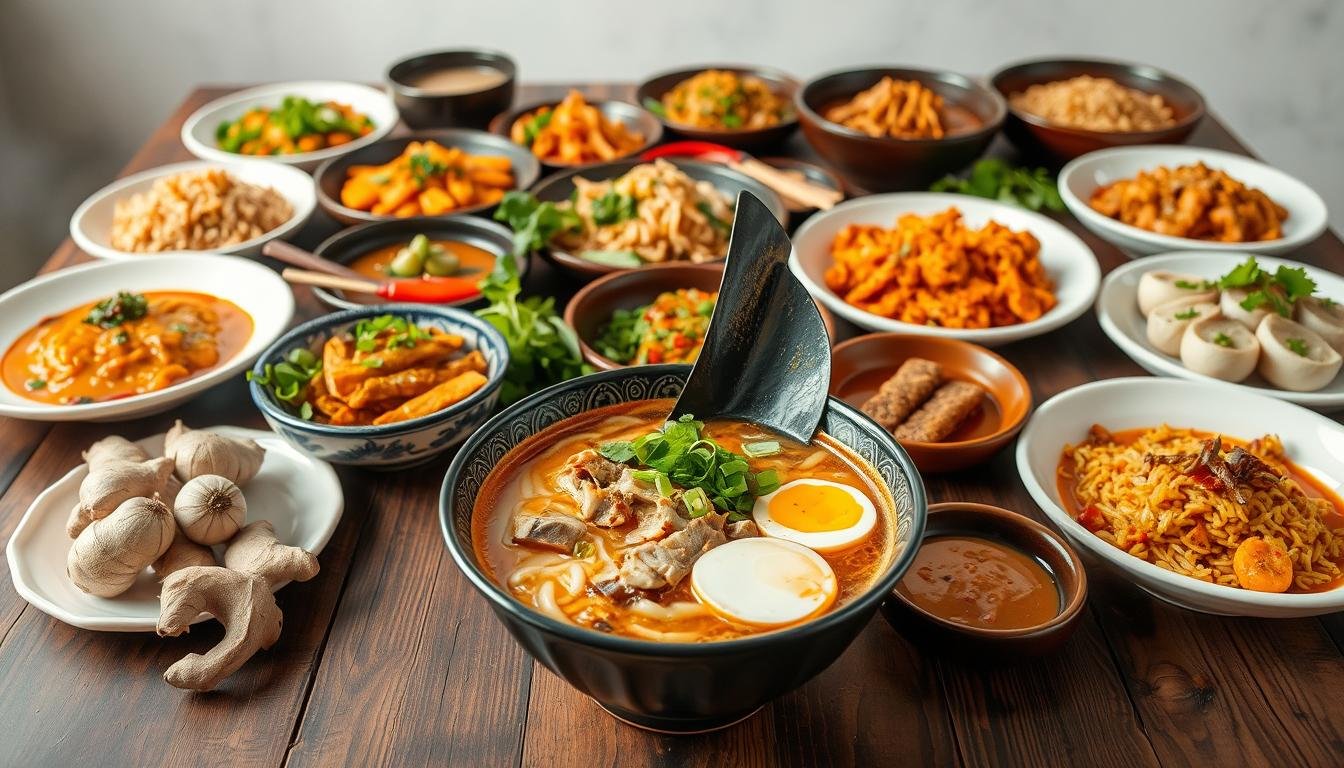
Asian dishes are a world full of flavor waiting to be found. I recall my first dive into this bold, aromatic world. It was like opening a box of treasures. Spices and ingredients made my taste buds dance. Have you ever eaten something that took you to another place, or even another time? That’s the wonder of Asian cuisine. With some simple recipes, you can bring this magic into your home.
Asian dishes stand out for their amazing variety. They mix tastes from all over the continent. You might try the hot spices of Thai food, the deep umami of Japanese dishes, or the warm, filling feel of Chinese meals. Every bite tells its own story. And you know what? You don’t have to be a pro chef to make these dishes at home. Any home cook can bring Asia’s lively flavors right to their kitchen table.
Key Takeaways
- Asian dishes offer a rich diversity of flavors and ingredients.
- Exploring Asian cuisine can be a delightful culinary adventure.
- You can recreate authentic Asian flavors at home with simple recipes.
- Each region of Asia brings unique tastes and staple foods to the table.
- Easy Asian recipes allow even beginners to enjoy these bold flavors.
Exploring the Rich Diversity of Asian Cuisine
Asian cuisine is colorful and diverse. It ranges from Bangkok’s busy streets to Tokyo’s calm sushi bars. It’s a mix of tastes and stories from across Asia.
Regional Variations Across Asia
Ever thought about how Asian food varies by country? Each place has its own favorite dishes. India loves spicy curries, while China prefers soft dim sums. Every dish tells a story of its home.
Culinary Influences that Shape Asian Dishes
History, trade, and migration have shaped Asian food. The Silk Road added spices to many dishes. In Vietnam, French influence added baguettes and coffee, making the Bánh mì sandwich. These influences mix to create food we love.
Essential Ingredients in Asian Cooking
When exploring Asian cuisine, key ingredients make each dish special. They are the foundation, adding depth and authenticity. These include aromatic spices, hearty rice, and delicate noodles. The variety is exciting and tasty!
Common Spices that Bring Heat
Asian spices add unique heat and depth. Sichuan peppercorns, garam masala, and star anise are kitchen staples. They make spicy curries and fragrant stir-fries better.
Staples: Rice, Noodles, and More
Rice and noodles are central to Asian meals. They range from simple jasmine rice to complex Vietnamese pho. These staples are great for absorbing flavors. Try buckwheat soba noodles, egg noodles, and sticky rice too!
The Art of Asian Cooking Techniques
Jump into the amazing world of Asian cooking methods. These methods boost flavors and keep your food nutritious. Explore stir-frying, steaming, and grilling to improve your cooking skills!
Stir-Frying: A Quick and Flavorful Method
Stir-frying is a key Asian cooking method. It uses high heat and quick movement. Ingredients get crispy on the outside and stay tender inside. This method lets you be creative with sauces and seasonings!
Steaming: Preserving Nutrients and Flavors
Steaming cooks food gently to keep its natural tastes and health benefits. It’s great for veggies, fish, and dumplings. Each bite is healthy and tasty. Steaming is ideal for those wanting to cook light without losing flavor.
Grilling: Infusing Smoky Goodness
Asian grilling goes beyond regular BBQ. It includes skewered meats and grilled veggies. The smoky flavor makes your dishes irresistible. Whether using a grill pan or an outdoor grill, it brings bold tastes to your table.
Now you know about these Asian cooking methods. It’s time to try them in your kitchen! You’ll love the delicious dishes you can make.
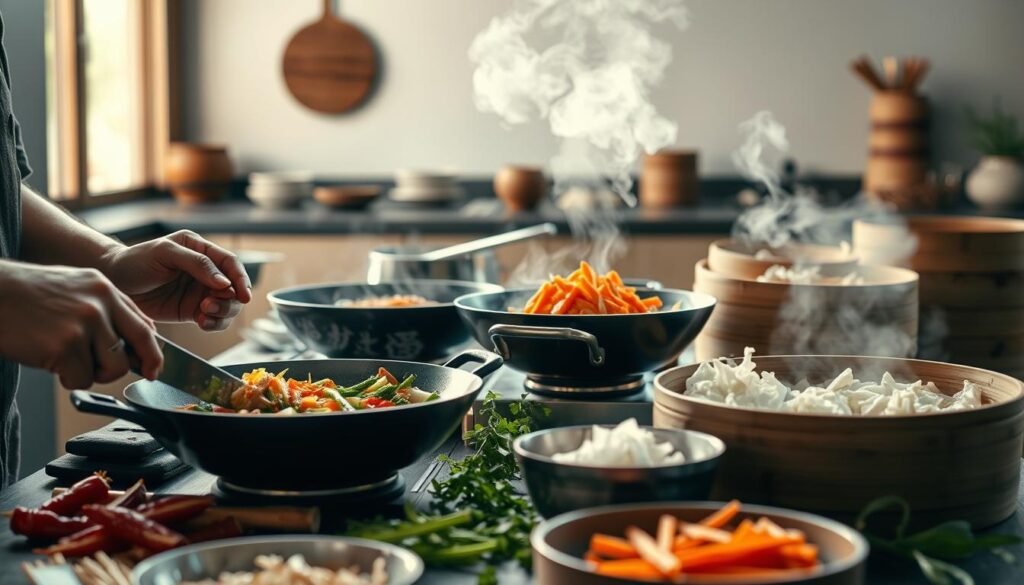
Famous Asian Dishes You Must Try
There’s nothing quite like the world of famous Asian dishes! Today, let’s explore three iconic dishes loved worldwide. We’ll look at Japanese sushi, Thai Pad Thai, and Chinese dumplings. These dishes show Asia’s rich food traditions. Ready to dive in?
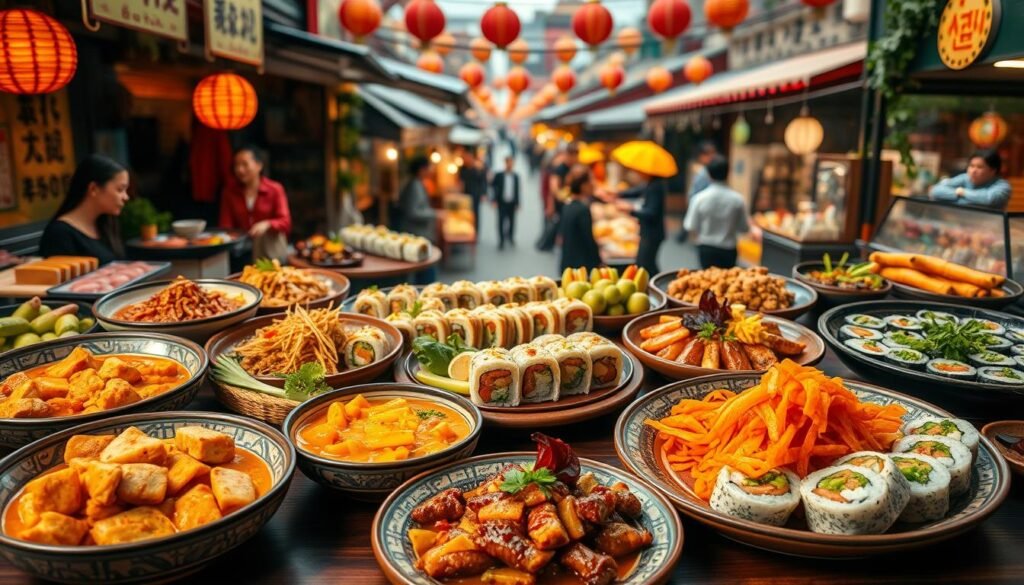
Sushi: A Japanese Culinary Icon
Sushi is a key dish in Japanese food. It mixes flavors and textures with fresh fish, rice, and seaweed. You can enjoy sushi in different places, from fancy bars to local stores. Making sushi shows Japan’s skill in cooking.
Pad Thai: Thailand’s Beloved Stir-Fried Noodles
Pad Thai is a favorite in Thai food. It’s stir-fried noodles with shrimp or chicken, tofu, eggs, and veggies. Tamarind sauce, peanuts, and lime add amazing flavors. Pad Thai’s taste is sweet, savory, and sour all at once.
Dumplings: A Taste of China
Dumplings are hard to resist and key in Chinese food. They come in various ways, like steamed, boiled, or pan-fried. Filled with meat and veggies, they’re eaten with soy and vinegar sauce. Dumplings are about comfort and tradition.
Vegetarian and Vegan Options in Asian Cuisine
Asian dishes offer many vegetarian and vegan choices. They are healthy and flavorful. These meals are a great way to try new foods.
Plant-Based Alternatives to Traditional Dishes
It’s fun to make Asian dishes with plants instead of meat. Use tofu, tempeh, or seitan in stir-fries. Chilli tofu is a spicy, tasty option without meat.
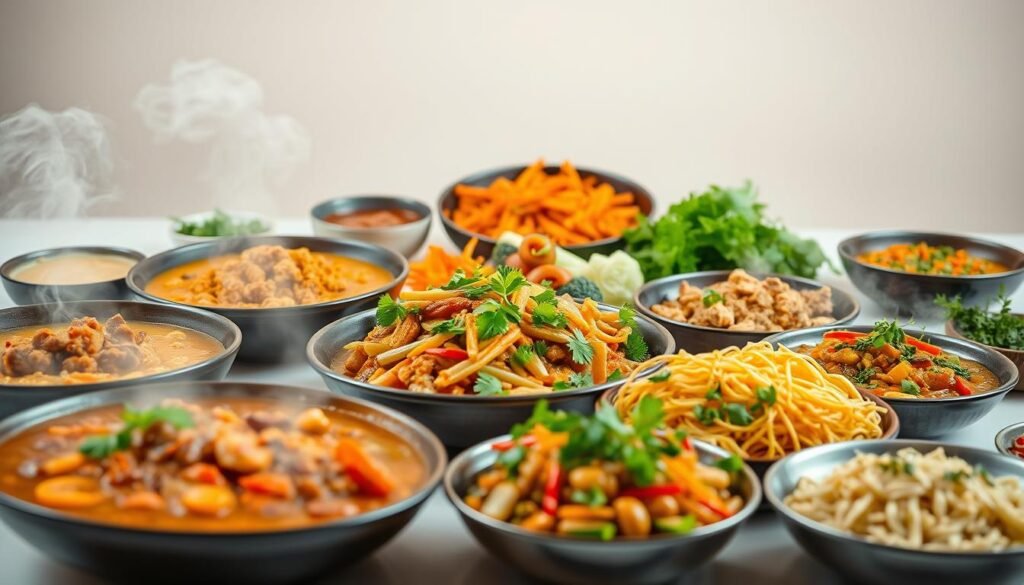
Vegan Asian foods often swap dairy for coconut or almond milk. This makes curries and desserts creamy and delicious. Imagine a vegan coconut curry with lemongrass and ginger. It’s cozy and full of flavor.
Popular Vegetarian Dishes Across Asia
Asian countries have many vegetarian meals to try:
- Buddha’s Delight (China): Vegetables, tofu, and sometimes noodles, all stir-fried.
- Dosa (India): A crispy crepe served with spicy potatoes and chutneys.
- Gado-Gado (Indonesia): A salad with boiled veggies, tofu, tempeh, and peanut sauce.
- Vegetable Sushi (Japan): Nori rolls with rice, cucumber, avocado, and more.
Eating vegetarian Asian dishes is fun and good for you. They are perfect for vegetarians or anyone wanting to eat more plants. Try Asian cuisine for tasty, plant-based meals!
Street Food Culture in Asia
Asian street food is truly fascinating. As you walk through lively markets and night bazaars, exotic smells and the sound of sizzling food draw you in. You’ll see food being made fresh right in front of you. Sellers all around offer tasty, cheap eats that let you taste the area’s spirit. All while you’re moving around.
The Experience of Eating On-the-Go
The joy of eating on-the-go in Asia is unmatched. Imagine walking in a busy Bangkok market. With each step, a new and tasty treat invites you to try. Think crispy rolls or spicy meat on sticks. The food is amazing! Eating this way lets you try lots of dishes without sitting down for a meal. You enjoy the moment and share these meals with new friends or travelers.
Notable Street Foods from Different Countries
The variety of notable street foods in Asia is huge:
- Thailand: Don’t miss Pad Thai. It’s got tamarind, peanuts, and lime.
- Vietnam: You must try Pho. It’s a soup with noodles and herbs.
- Japan: Takoyaki are tasty. They’re ball-shaped and filled with octopus.
- China: Jianbing is a must. It’s a crispy crepe with eggs and sauces.
- India: Pani Puri is great. They’re filled with spicy water and chickpeas.

Exploring Asian street food is an adventure. It lets you dive into the culture, creativity, and warmth of the region. Street food in Asia can range from quick bites to gourmet treats. Every taste is a memory to cherish.
The Role of Herbs in Asian Dishes
Asian cuisine is full of life, thanks to the various herbs used. These herbs don’t just add flavor. They are key in making dishes special. They make meals more enjoyable and interesting.
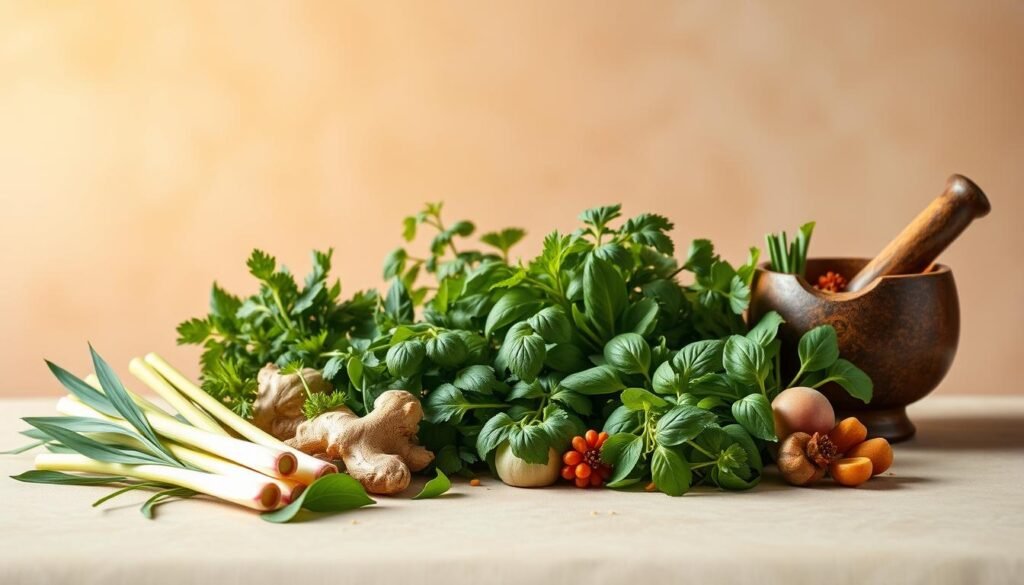
Fresh Herbs that Elevate Flavors
In many Asian homes, fresh herbs are essential. They are more than just decorations. Herbs like Thai basil, cilantro, and mint turn simple food into something amazing. They add a layer of taste that makes the food better. Adding fresh basil to pho, for example, enhances its aromatic broth impressively.
Traditional Uses of Herbs in Various Regions
Across Asia, each area has its own way of using herbs. Vietnamese spring rolls are filled with mint, cilantro, and Thai basil. This blend creates vibrant flavors. In China, scallions and ginger add depth to soups and stir-fries. These herbs do more than flavor food. They keep us connected to deep cultural roots and regional flavors.
Dessert Delights: Sweet Treats from Asia
Asian desserts are full of unique flavors. They range from traditional sweets to new takes by modern chefs. Everyone can find a favorite here!
Traditional Asian Desserts Worth Celebrating
Asian desserts have a long history. They use beloved ingredients and old techniques. Enjoy the creamy Japanese mochi or the sweet Indian gulab jamun for a taste of the past. Here are a few examples:
| Dessert | Description |
|---|---|
| Chinese Mooncakes | A round pastry filled with sweet red bean or lotus seed paste, often enjoyed during the Mid-Autumn Festival. |
| Vietnamese Che Ba Mau | A vibrant, layered dessert featuring beans, coconut milk, and jelly, creating a colorful and refreshing treat. |
| Indian Jalebi | Crispy, deep-fried spirals soaked in sugar syrup, offering a delightful combination of crunch and sweetness. |
Contemporary Takes on Classic Favorites
Now, chefs worldwide are updating traditional sweets. Imagine a matcha tiramisu or black sesame cheesecake! These new desserts keep the spirit of the originals but add something exciting.
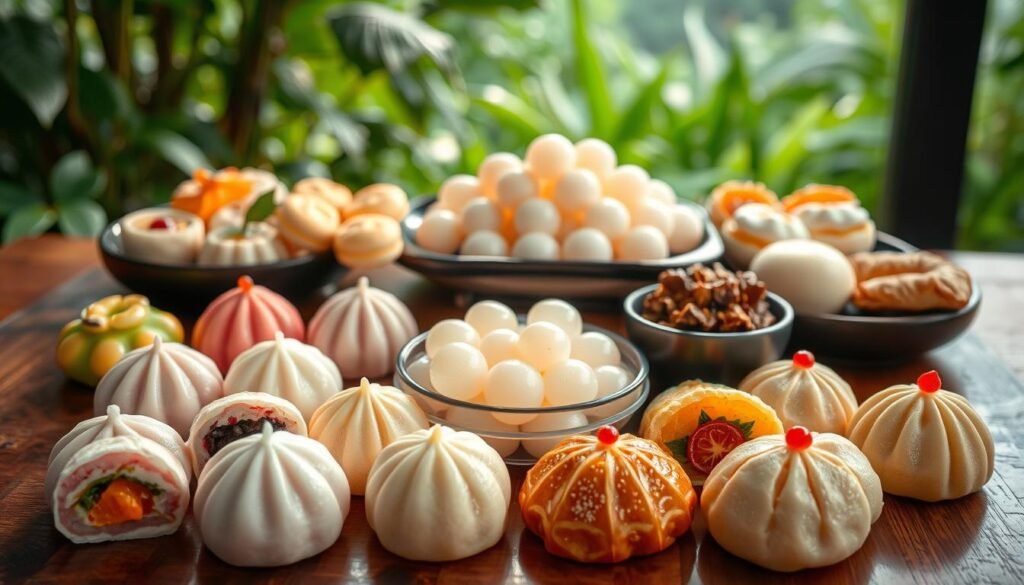
Love classic treats or want to try something new? The world of Asian desserts has so much to offer. Explore and enjoy these amazing flavors!
Pairing Asian Dishes with Drinks
Exploring Asian cuisine? The right drink can make your meal even better. Let’s look at the best tea and Asian-inspired cocktail pairings.
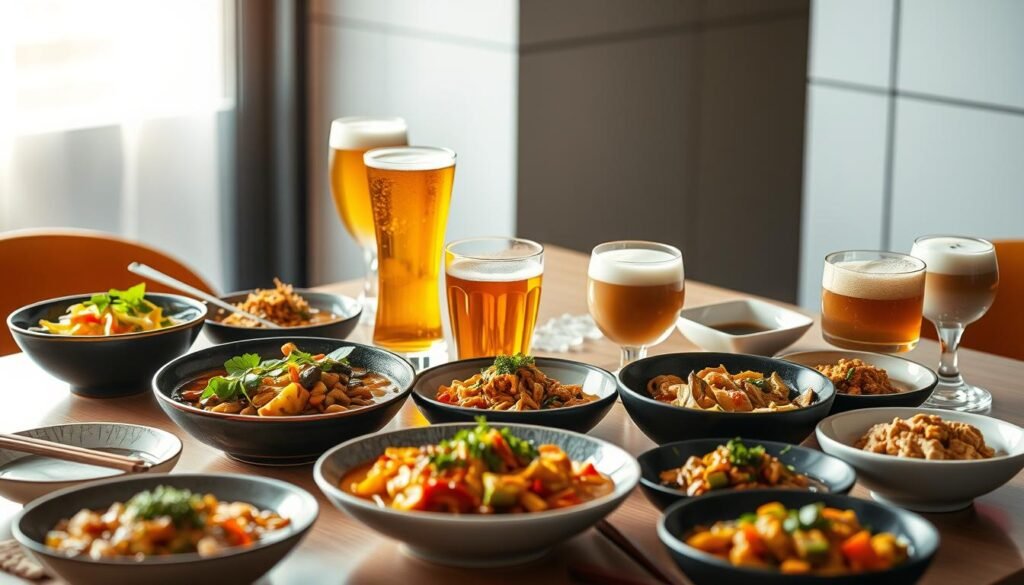
Tea: The Perfect Accompaniment
Tea is key in many Asian cultures and pairs well with lots of dishes. You can choose from bold Chinese Pu-erh to fresh Japanese Green Tea. Picture enjoying jasmine tea with Vietnamese Pho—it’s a perfect match! Tea not only adds to the meal’s taste but also relaxes you.
Asian-Inspired Cocktails to Complement Meals
Want to spice up your meal? Try Asian-inspired cocktails! These drinks mix traditional cocktails with Asian tastes. Imagine a sake martini with sushi or a lychee mojito with Thai curry. This mix of flavors brings a perfect balance.
Finding the right drink can turn a simple meal into a rich culinary journey. Choose from calming tea or an inventive cocktail. Here’s to a meal that delights all your senses!
Cooking Asian Dishes at Home
There’s nothing better than making your favorite Asian dishes at home! I’ll share some key kitchen tools and tips. These will help make your homemade meals as good as restaurant ones.
Essential Kitchen Tools You’ll Need
To cook Asian dishes at home, you need some basic tools. These tools make cooking easier and help your food taste authentic.
| Tool | Use | Example |
|---|---|---|
| Wok | Perfect for stir-frying dishes at high heat. | Carbon steel wok |
| Rice Cooker | Makes cooking rice a breeze, ensuring perfect texture. | Zojirushi Rice Cooker |
| Mortar and Pestle | Ideal for grinding spices to release full flavors. | Granite mortar and pestle |
Tips for Authentic Asian Cooking
Making Asian dishes at home is easier than you think. Here are my top tips:
- Always use fresh ingredients, especially herbs and veggies. They really improve the flavor.
- Don’t forget to marinate! It gives your food great taste.
- Learn to mix flavors—sweet, salty, sour, and umami. It’s important for Asian cooking.
Getting the right tools and using these tips will help you succeed. The more you cook, the better you’ll get. Soon, you’ll be making amazing dishes in your own kitchen!
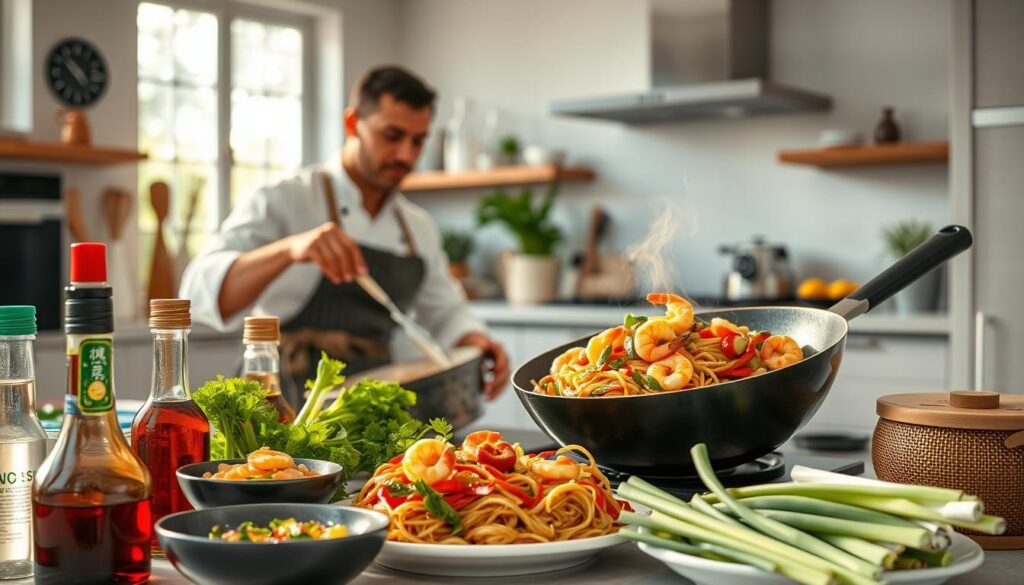
Health Benefits of Asian Cuisine
Asian cuisine is more than just tasty. It’s also very good for your health! The ingredients are full of nutrients and the flavors are just right. I’ve noticed a big change in how I feel since I started eating more Asian food. Let’s look at why Asian cuisine is so great.
Nutrient-Rich Ingredients in Asian Dishes
Asian food is known for its healthy ingredients. Lots of dishes have veggies, lean meats, and whole grains. Imagine stir-fries full of colorful veggies like bell peppers and carrots, or sushi with seafood and avocado. These foods taste great and are good for you, giving you fiber, vitamins, healthy fats, and more.
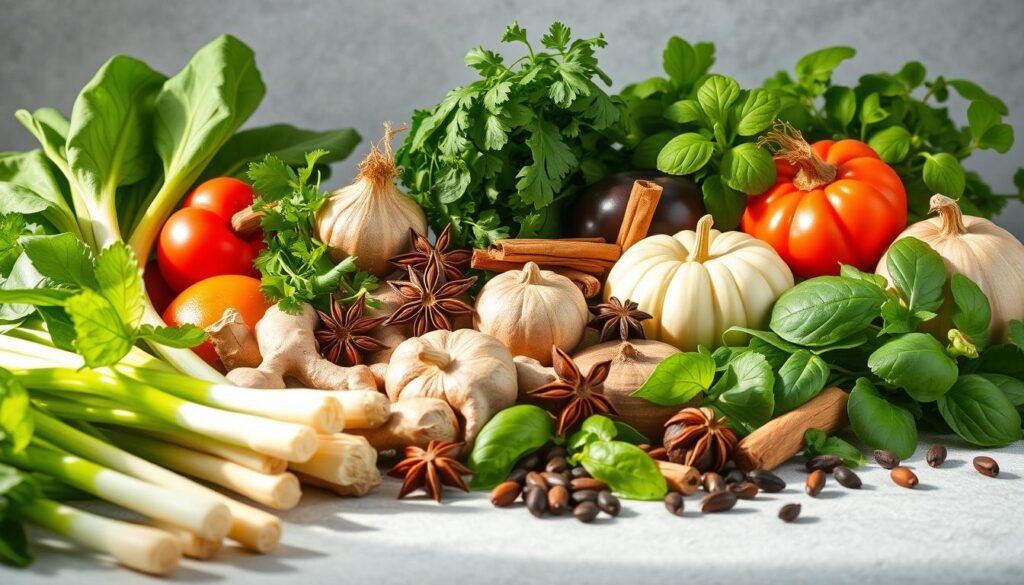
The Balance of Flavors for Wellness
The balance of flavors in Asian food is also key to its health benefits. Mixing sweet, salty, sour, and bitter tastes is not only about good flavor. It’s also good for you. Ingredients like ginger, garlic, and turmeric add taste and have health benefits. They can reduce inflammation and are antioxidants. This balance makes meals healthy and fulfilling, helping you eat better.
Next time you try new recipes, think about Asian cuisine. It’s not just yummy—it’s also packed with health perks. Enjoy cooking with these healthy ingredients and balanced flavors. They’re great for your well-being!
Conclusion: Embarking on Your Asian Culinary Adventure
Starting an Asian culinary adventure is thrilling. You open a world full of bright tastes, smells, and textures. It’s a great time to begin making these yummy dishes at home. Whether new or skilled in cooking, there’s always something exciting to find and love.
Encouragement to Experiment with Flavors
My advice: don’t be scared to mix up flavors! Asian food lets you be really creative. You can mix ingredients, try new spices, and change recipes to what you like. Cooking is all about learning and having fun. Sometimes, the best meals are born from playing with flavors. You might even create a dish that’s all yours!
Resources for Further Exploration of Asian Dishes
To dive deeper into Asian cooking, many resources can help. Cookbooks from famous chefs like Ken Hom, Ching-He Huang, and Madhur Jaffrey are full of great recipes and tips. You can find many how-to videos on YouTube too. And don’t forget to join cooking groups online. They’re great for sharing and getting tips.
Now, get into your kitchen and start exploring Asian flavors with excitement. Happy cooking!